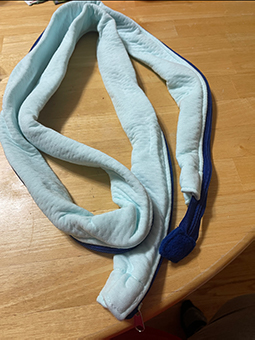Heated CPAP Tubing Versus CPAP Hose Covers
I was out of town with my CPAP when a foreign issue presented itself. I had drifted off to sleep, but about an hour later, I woke up to freezing cold air coming from my CPAP machine.
I have the Air Sense 10, and I usually struggle with night sweats or being hot with the mask on, but as the temperatures dipped and the room was super cold, I was shocked awake from a freezing burst of air from my machine.
I cannot tolerate the cold air
I tried to turn it off and let it ramp to see if it would be better, but no, the air was super cold. After 2 hours of cold air, I had to remove the mask and sleep without.
The worst feeling is waking up to freezing cold air. It is uncomfortable, and when it continued to stay cold after turning the CPAP off and letting it restart, the cold chill was too much. I took the CPAP off and went to sleep on the couch.
Options to warm the air in my CPAP tubing
That led me to the internet, where I started searching for options.
I found 2 options. One was heated CPAP tubing you can purchase. The other was this weird thing that looked like a sock to go on my existing tubing for the machine. I weighed the cost and went with the weird tube covering.
Ordering a hose cover
I found a tube cover on Amazon and for $8.00 and free shipping, I decided to try this option first before ordering new tubing. I have made a note when I’m eligible for a new hose in 3 months to see if it’s an option to get the heated tubing directly from my CPAP supply company.
I ordered the tube covering at 3:00 AM, and it arrived the same day. See the picture below for what it looked like.

It’s a blue tubing that is layered and slides down the tubing and has Velcro at the top that helps keep it in place.
After getting the tubing cover all set up, I was a little scared to put the CPAP on because I wasn’t sure if it would work. I didn’t want to get too comfortable to be startled again with freezing cold air.
The bad part is the air doesn’t feel bad when it’s ramping up, but once you drift off to sleep and it’s blowing full pressure, it intensifies and makes the cold feeling unbearable.
The first night with my hose cover
So the first 40 minutes of the ramp weren’t bad. The light air felt warmer with the tubing cover on, and after horrible sleep without it the night before, I drifted off to sleep. I was pleasantly surprised when I woke up at 9 AM. I made it through the night, and the simple hose cover did the trick in warming up the air.
I dislike having the strong air from the CPAP blowing in my face all night. Using my CPAP is already a struggle, but I wasn’t ready for the freezing cold blast I received with my machine. I’m really happy to have found a cheap but effective way to help combat the icy cold air with my machine.
Maybe heated tubing or a humidifier is in my future
I’m hoping that when I replace my machine in the next year or so, there will be heat built into the humidifier to keep the air moist and at a comfortable temperature throughout the night.
Until I can upgrade my machine, I will investigate switching to the heated tubing when I have to restock my supplies next.
Have you ever had an issue with the temperature of the air in your machine? If so, let me know what worked for you.

Join the conversation